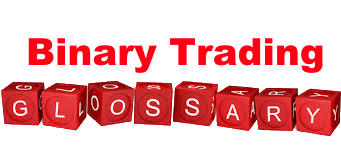Trading Glossary – Binary Options
A list of terms used in Binary Options Trading – Trading Glossary
Understanding Trading Glossary is important. Basic Binary Options “expressions” so to say is key to starting your career as a trader the right way. So, OptionsWay.com presents its own Trading Glossary for binary options. It’s a fast read and please take it as terminology essentials. Don’t stop there and go beyond the surface. At the end of this article you will find some cool links to continue your education.
Strike price: the strike price is the price at which the owner of an option can buy or sell the underlying currency pair or asset.
Call Option: if one thinks that the rate of a currency pair will go up, he will purchase the call option. A call option expresses a trader’s bullish view of the market.
Put Option: if one thinks that the rate of a currency pair will go down, he will purchase the put option. A put option expresses a trader’s bearish view of the market.
In-the-money: A call option is in the money if the current rate of the underlying currency is higher than the strike price. If at the expiration time, the rate is higher than the strike price, it means that the option expired in the money, thus giving us a profit.
A put option is in the money if the current rate of the underlying currency is lower than the strike price. If at the expiration time, the rate is lower than the strike price, it means that the option expired in the money, thus giving us a profit.
At-the-money: Options are at-the-money when the strike price coincides with the current price of the underlying asset or currency pair. The term near-the-money is used to describe a price very close to the strike price.
Out-of-the-money: A call option is out-of-the-money if at the expiry time, the price of the underlying asset or currency pair is below its strike price.
A put option is out-of-the-money if at the expiry time, the price of the underlying asset or currency pair is above its strike price.
Expiry time: The time and date when the option expires.
Expiry price: The current price of the underlying asset or currency pair when the option expires.
Payout: The amount received by the investor if the option expires in the money
Break Even Point: The point (price) where your transaction costs are covered by the current unrealized profit; the point where if you close all open transactions, you don’t take a loss but you don’t make any profit either.
Bid/Ask Spread: The difference between the bid and ask price. Usually, options with more liquidity tend to have a tighter spread, while options that are rarely traded and as a consequence, less liquid, have a wider spread.
Derivatives: A financial instrument whose value is determined in part by the value of another financial instrument. Forex Options are derivatives, because their value is derived from the price of the underlying currency pair.
Find out more: Binary Options Guide and learning How to Trade Binary Options





